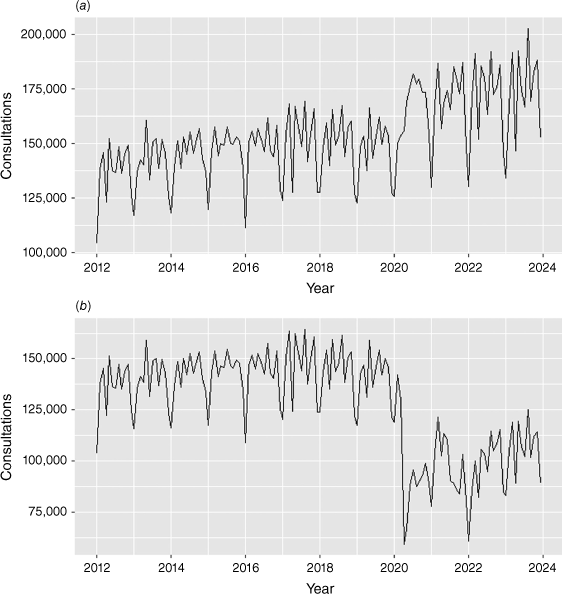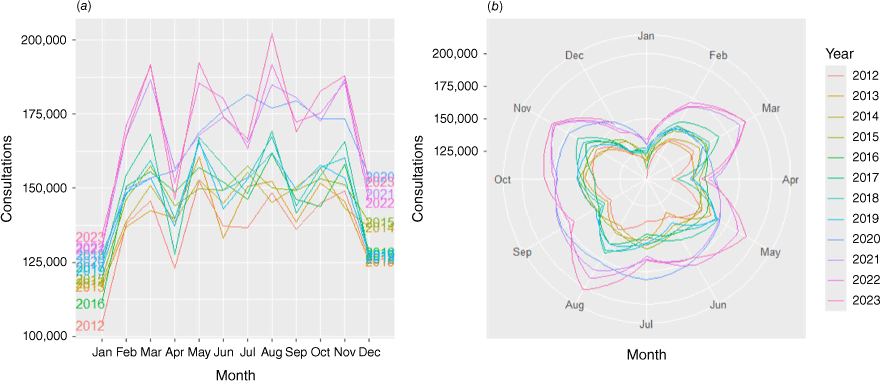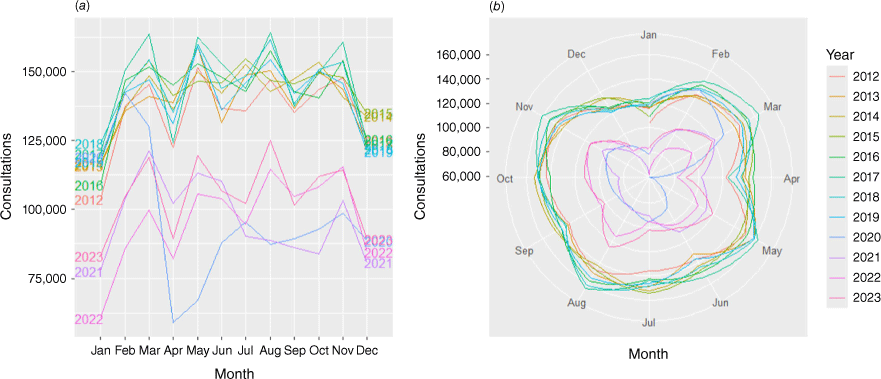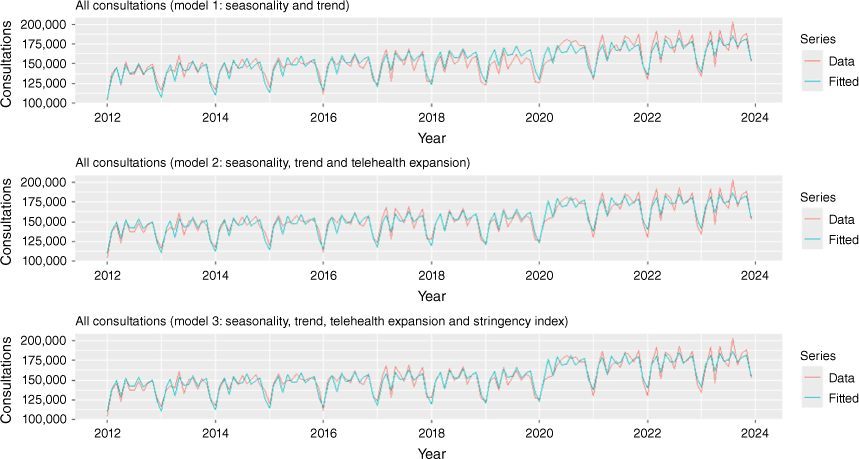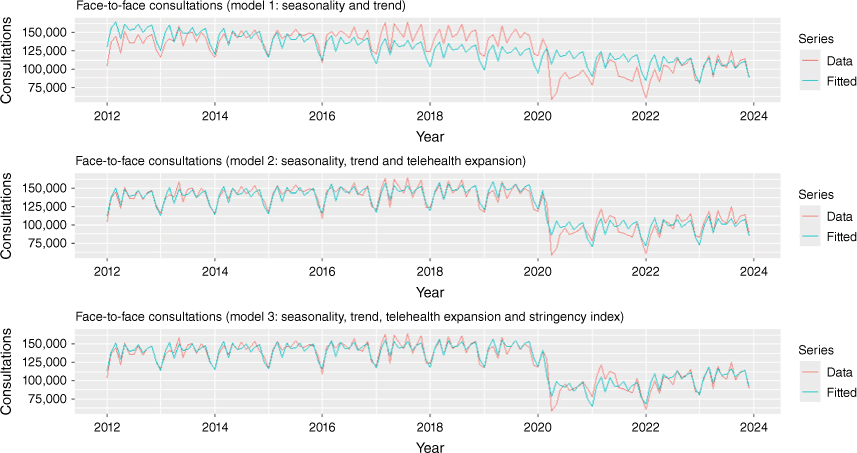Medicare-reimbursed psychiatric consultations before and after telehealth expansion in Australia: a time series study
Luke Sy-Cherng Woon A B * , Paul A. Maguire A C , Rebecca E. Reay A , Murthy Mittinty D , Tarun Bastiampillai C D and Jeffrey C. L. Looi
A B * , Paul A. Maguire A C , Rebecca E. Reay A , Murthy Mittinty D , Tarun Bastiampillai C D and Jeffrey C. L. Looi  A C
A C
A
B
C
D
Abstract
Telepsychiatry consultations grew rapidly with increased total consultations and reduced face-to-face consultations following the pandemic-triggered expansion of Medicare Benefits Schedule (MBS) telehealth items. It was unclear how much telehealth expansion independently impacted overall and face-to-face consultation trends after accounting for lockdown severity.
We extracted monthly MBS Item Reports for psychiatric consultations (January 2012–December 2023). The monthly average Stringency Index (SI) for Australia represented lockdown severity from January 2020 to December 2022. A dichotomous variable denoted telehealth expansion (March 2020 onward). We constructed consecutive multiple linear regression models for combined consultations and face-to-face consultations to include seasonality, trend, SI, and telehealth expansion. We compared model performance using information criteria.
Median monthly total consultations increased from 148,413 (Interquartile range, IQR: 138,219–153,709) pre-expansion (January 2012–February 2020) to 173,016 (IQR: 158,292–182,463) post-expansion (March 2020–December 2023). Contrarily, median monthly face-to-face consultations decreased from 143,726 (IQR: 135,812–150,153) to 99,272 (IQR: 87,513–107,778). Seasonality and trend were present in both time series. The time series regression model with expansion but excluding SI best explained all consultations, while both telehealth expansion and SI were significant in the best-fit model for face-to-face consultations.
MBS telehealth expansion was associated with total and face-to-face consultations independent of lockdown severity changes. Policy changes allowing wider access to new telehealth services have possibly led to increased uptake of psychiatric care and addressed previously unmet needs.
Keywords: access to care, health policies, interrupted time series analyses, outpatients, psychiatry, remote consultations, telehealth, telepsychiatry.
Introduction
In March 2020, in response to the COVID-19 pandemic, the Australian Government expanded access to telehealth, including telepsychiatry, in the Medicare Benefits Schedule (MBS). For the new MBS telehealth items, geographic restrictions for the pre-existing telepsychiatry items no longer applied, extending access to both metropolitan and rural areas.1,2 These telepsychiatry items, including both video and telephone items, were initially introduced temporarily, but most video items have been made permanent since June 2022.3
In 2002, reimbursement for telepsychiatry video consultations was first introduced through the MBS.4 Only patients from rural and remote areas were eligible for these items. A telehealth co-claim item (Item 288) with 50% fee-loading was introduced in 2011. For a long time, MBS telepsychiatry usage was very low compared with face-to-face consultations. From July 2002 to June 2011, telepsychiatry consultations comprised only 0.06% of all psychiatric consultations.4
Since the MBS telehealth expansion in the early phases of the pandemic in 2020 and 2021, there has been a rapid growth in telepsychiatry consultations,5–8 analogous to the growth of other telemental health services since the introduction of new telehealth items.7 Concurrently, there was an increase in overall psychiatric consultations during this period,9 while another study reported a 22% drop in face-to-face psychiatry consultations across Australia in 2020.10 However, existing studies did not adjust for pandemic lockdown severity, which could be an important factor in the choice of consultation modes.
A time series analysis covering the later pandemic period (2022 onward), and adjusting for the effects of lockdown severity on overall and face-to-face psychiatric consultations, could produce a better understanding of temporal trends in psychiatric consultations and have practical implications for service planning and resource allocation. We hypothesised that MBS telehealth expansion led to both increased total psychiatric consultations and reduced face-to-face consultations, after adjusting for the effects of nationwide lockdown severity measures.
Methods
Data sources
Monthly counts of MBS items for psychiatric consultations in three modes: face-to-face, video, and telephone, were obtained from the publicly available MBS Item Reports.11 The MBS items included are listed in Table 1. Item Reports from January 2012 to December 2023 were merged to produce two sets of time series, namely, a face-to-face consultations time series and a combined consultations (face-to-face, video, and telephone consultations) time series. To capture telehealth expansion, a categorical time series was created. Telehealth expansion was recorded as ‘no’ from January 2012 to February 2020 and ‘yes’ from March 2020 to December 2023.
| Service | Face-to-face | Video | Telephone | |
|---|---|---|---|---|
| Consultation, not more than 15 min | 300, 364 A, C | 91827, 353 A, B | 91837 | |
| Consultation, 15–30 min | 302, 366 A, C | 91828, 355 A, B | 91838 | |
| Consultation, 30–45 min | 304, 367 A, C | 91829, 356 A, B | 91839 | |
| Consultation, 45–75 min | 306, 369 A, C | 91830, 357 A, B | 91840 A | |
| Consultation, more than 75 min | 308, 370 A, C | 91831, 358 A, B | 91841 A | |
| Prepare a treatment and management plan, patient under 13 years with autism or another pervasive developmental disorder, at least 45 min | 289 | 92434 | 92474 A | |
| Prepare a management plan, more than 45 min | 291 | 92435 | 92475 A | |
| Review management plan, 30–45 min | 293 | 92436, 359 A, B | 92476 A | |
| Attendance, new patient (or has not received attendance in preceding 24 months), more than 45 min | 296 | 92437, 361 A, B | 92477 A | |
| Interview of a person other than patient, during initial diagnostic evaluation of patient, 20–45 min | 348 | 92458 | 92498 A | |
| Interview of a person other than patient, during initial diagnostic evaluation of patient, 45 min or more | 350 | 92459 | 92499 A | |
| Interview of a person other than patient, while continuing management of patient, not less than 20 min, not exceeding four attendances per calendar year | 352 | 92460 | 92500 A | |
| Group psychotherapy, at least 1 h, involving group of 2–9 unrelated patients or a family group of more than three patients, each referred to consultant psychiatrist | 342 | 92455 | 92495 A | |
| Group psychotherapy, at least 1 h, involving family group of three patients, each referred to consultant psychiatrist | 344 | 92456 | 92496 A | |
| Group psychotherapy, at least 1 h, involving family group of two patients, each referred to consultant psychiatrist | 346 | 92457 | 92497 A | |
| Prepare an eating disorder treatment and management plan, more than 45 min | 90260 | 92162, 90262 A | 92166 A | |
| Review an eating disorder plan, more than 30 min | 90266 | 92172, 90268 A | 92178 A | |
| Telehealth co-claim item (old) | 288 A | |||
| Telehealth co-claim item (new) | 294 B |
The Stringency Index (SI) for Australia, produced by the Oxford COVID-19 Government Response Tracker (OxCGRT) project,12 was used to represent the timing and severity of pandemic-related government responses. It was a composite index consisting of nine response metrics (school closures; workplace closures; public event cancellations; public gathering restrictions; public transport closures; stay-at-home requirements; public information campaigns; internal movement restrictions; and international travel controls). It ranged from 0 to 100, with 0 reflecting no measures taken and 100 reflecting the strictest responses in all nine measures. Volunteers performed data collection and coding for the OxCGRT project, with coder training, testing, and regular meetings to ensure coding consistency.13 We retrieved the Australian national index weighted for the proportion of the vaccinated population (available from January 2020 until December 2022). The daily index was converted into monthly average values. Before January 2020 and after December 2022, the index values were set at zero.
Data analysis
The R program was used for analyses14 via RStudio.15 Descriptive analyses were performed for two separate time series: (1) face-to-face consultations and (2) combined total consultations. The tslm() function was used to fit multiple linear regression models to the data, including trend and seasonality components.16 The regression analysis was performed separately for two dependent variables: face-to-face consultations and combined consultations (CONSULTATIONS). The independent variable of interest was telehealth item expansion (EXPANSION). The analysis was conducted in three steps. The first model was the basic model with months (m2, m3, m4 … m12) and trend (t) to account for seasonality and trend in the time series, while β0 was the intercept and ε was the error term:
In the second model, the variable of interest, EXPANSION, was included:
In the third step, an SI (STRINGENCY) variable was added as a covariate to adjust for the effects of COVID-related restrictions:
The predicted values were then plotted against actual data for inspection. We also compared the adjusted R2, corrected Akaike’s Information Criterion (AICc), and Schwarz’s Bayesian Information Criterion (BIC) of the models to evaluate their performance.
By progressively adding the independent variables in the models and comparing the information criteria, we intended to explore whether these variables contribute to the sufficiency of the models while keeping the models parsimonious. By implementing a stepwise approach, we were aware that we were creating an omitted variable bias. However, the initial models without all relevant variables were intended to demonstrate how much telehealth expansion and SI explained the variation in consultations, and we did not wish to interpret the results of models with omitted variables as final.
Results
Descriptive analyses
There were 22,075,341 consultations for all included MBS items for psychiatric consultations, 18,375,380 of which were face-to-face psychiatric consultations (83.3%). There was a 16.6% increase in the median monthly total psychiatric consultations from 148,413 (IQR: 138,219–153,709) in the pre-expansion period (January 2012 to February 2020) to 173,016 (IQR: 158,292–182,463) post-expansion (March 2020 to December 2023). In contrast, median monthly face-to-face psychiatric consultations decreased by 30.9% from 143,726 (IQR: 135,812–150,153) to 99,272 (IQR: 87,513–107,778) for the same periods. The proportion of face-to-face psychiatric consultations compared to total psychiatric consultations declined from 97.5% in the pre-expansion period to 57.3% in the post-expansion period. The average monthly SI (minimum: 1.3, January 2020: and maximum: 75.1, April 2020) rose sharply in early 2020 and fluctuated at medium-to-high levels before declining and stabilising at 11.1 from August 2022 to December 2022.
The time series for combined psychiatric consultations displayed an increasing trend component and a seasonal component, which became less distinct in 2020 (Fig. 1a). The seasonal plot (Fig. 2a) and polar seasonal plot (Fig. 2b) demonstrate the presence of a seasonal pattern for most years, with higher numbers of psychiatry services in March, May, August, and November. This monthly pattern was less clear for 2020 and 2021. Conversely, the lowest numbers were seen in January, followed by December.
For face-to-face psychiatric consultations, a clear reduction was seen at the onset of the COVID-19 pandemic in early 2020 (Fig. 1b). Both seasonal and polar seasonal plots (Figs 3a, b) present a clear seasonal pattern with higher numbers in March, May, August, and November, except in 2020 and 2021. The pattern resumed in 2023. The lowest numbers were in January and December every year.
Multiple regression models
The results for the multiple linear regression models are shown in Table 2. For all consultations, telehealth expansion was a significant positive factor after adjusting for seasonality, trend, and SI. There was a small but statistically significant positive trend. SI was not statistically significant. Model 2, which contained telehealth expansion but excluded SI, performed better than Model 3, which included it. In this model, telehealth expansion was associated with an increase of 13,684 for monthly consultations (95% CI: 9487, 17,881) which was clinically significant, equivalent to 9.2% of the pre-expansion median monthly total consultations. In Fig. 4, the fitted values from the models are plotted against actual data.
| Model 1 | Model 2 | Model 3 | ||
|---|---|---|---|---|
| All consultations | ||||
| Variables, coefficient (95% CI) | ||||
| Trend | 264.43 (232.69, 296.17) | 140.16 (93.02, 187.29) | 141.50 (92.55, 190.46) | |
| Expansion | – | 13,684.30 (9487.40, 17,881.20) | 13,300.00 (7782.04, 18,824.71) | |
| Stringency | – | – | 7.83 (−65.50, 81.16) | |
| Accuracy metrics | ||||
| Adjusted R 2 | 0.817 | 0.860 | 0.859 | |
| AICc | 2605.045 | 2567.551 | 2570.035 | |
| BIC | 2643.367 | 2608.349 | 2613.269 | |
| Face-to-face consultations | ||||
| Variables, coefficient (95% CI) | ||||
| Trend | −441.60 (−441.60, −303.73) | 105.30 (23.71, 308.41) | 66.67 (12.90, 120.44) | |
| Expansion | – | −52,632.60 (−57,759.34, −47,505.83) | −41,667.87 (−47,732.08, −35,603.67) | |
| Stringency | – | – | −225.28 (−305.82, −144.74) | |
| Accuracy metrics | ||||
| Adjusted R 2 | 0.516 | 0.883 | 0.905 | |
| AICc | 2828.425 | 2625.188 | 2597.045 | |
| BIC | 2866.747 | 2665.985 | 2640.279 | |
Model 1: seasonality, trend; Model 2: seasonality, trend, expansion; Model 3: seasonality, trend, expansion, stringency. Dummy variables for months are not listed.
For face-to-face consultations, telehealth expansion was also a statistically significant factor after adjusting for seasonality, trend, and SI in the final model, with a negative association with consultations. SI remained an important factor that appeared to explain the variation in face-to-face consultations. Similarly, there was a small but significant positive trend. Model 3 provided the best fit (Table 2 and Fig. 5). Telehealth expansion was associated with a clinically considerable decrease of 41,668 face-to-face consultations per month (95% CI: −47,732, −35,604), while each point of SI was associated with 225 fewer monthly consultations (95% CI: −306, −145).
Discussion
We examined the impact of MBS telehealth expansion on psychiatric consultations. Using time series multiple linear regression models, we adjusted for long-term trends and seasonality as well as the severity of COVID-19 public health measures. We identified considerable changes in all consultations and face-to-face consultations that cannot be explained by pre-existing seasonality and trend alone. After adjusting for COVID-related restrictions, telehealth expansion was associated positively with all consultations combined, and negatively with face-to-face consultations at clinically significant levels. SI might partly explain the decline in face-to-face consultations but was not associated with the levels of combined (face-to-face and telehealth) consultations.
These results suggest two phenomena. First, there was a shift away from face-to-face to telehealth consultations that cannot be accounted for by COVID-related restrictions alone, i.e. there appeared to be a sustained demand for telepsychiatry even when COVID-related restrictions were largely revoked. This implies that both clinicians and patients may accept telehealth as a legitimate alternative or adjunct to face-to-face consultations. While advances in videoconferencing technology in recent years have rendered it more affordable and accessible, this factor might be necessary but not sufficient to explain the change. The contingent need to use telehealth during the pandemic might be the catalyst. As a healthcare service, telepsychiatry can be conceptualised as an ‘experience good’ that can only be accurately evaluated and compared to face-to-face consultations after the service has been purchased and experienced.17 Most patients were not eligible for telepsychiatry consultations under Medicare before the pandemic. When people had a clinical context and the opportunity to utilise telepsychiatry, many rated it as not inferior to in-person sessions,18 and might continue to make use of it consequently.
Second, a comparison of the findings of the 2020–2022 National Study of Mental Health and Wellbeing (NSMHW) and the 2007 NSMHW indicates only slight changes in the lifetime and 12-month prevalence of mental illness among Australians, despite more observable changes among certain demographic groups, such as young female adults.19 Given this background, a possible interpretation of the increased usage of MBS psychiatric consultations could be improved service access since telehealth item expansion. Accessible telehealth consultations might have allowed individuals who previously could not see a psychiatrist for various reasons (time constraints, carer duties, travel distance, etc.) to obtain the help they needed with Medicare reimbursement, thus addressing previously unmet mental health needs. However, whether telehealth availability could improve access at a broad population level requires further investigation. Out-of-pocket costs of telehealth consultations may be a barrier to patients. Medicare claim data from 2021 to 2022 showed that higher proportions of patients were not bulk-billed, with greater out-of-pocket costs for video consultations compared with face-to-face equivalents.20 In 2022 and 2021, a decline in the inequity of the distribution of face-to-face psychiatric consultations was observed, but the newly introduced video consultations showed severe inequity across areas ranked according to socioeconomic disadvantage.10 Whether telehealth consultations might amplify health inequity should be examined.
Additionally, there was a temporary disruption of the regular seasonal pattern of psychiatric consultations in 2020 during the peak of the pandemic. While this is perhaps understandable in light of the unprecedented pandemic demands, it also indirectly highlights that seasonality is the norm in MBS outpatient psychiatric services. While seasonal variations in psychiatric symptomatology are known,21 and their effects on psychiatric hospital admissions have been extensively studied,22 there are only a few reports of seasonal variations in psychiatric outpatient presentations, with inconsistent findings.23,24 Given that seasonal changes in patient load are an important consideration in health service planning and resource allocation,25 the seasonality of MBS psychiatric consultations requires further exploration, including the longer-term impact of telehealth utilisation on seasonal variations.
In contrast to previous time series analyses, this study analysed the national MBS data over a longer period (January 2012–December 2023), provided more data points, and increased the statistical power of the analysis.26 Our study, to the best of our knowledge, was the first that incorporated a measure of pandemic-related restriction severity, i.e. SI, in the analysis of the impact of MBS telehealth expansion. Nevertheless, this study had several limitations. The data were derived from routinely collected MBS claims data at the point of processing, with a possible lag from the original consultation time. Furthermore, in the dataset, patient clinical characteristics, such as diagnoses and symptom severity, and socioeconomic variables that could have influenced service utilisation, were unavailable. Finally, while we controlled for COVID-related effects using SI, it might not have adequately captured the financial, practical, and psychological impact of the pandemic, and there could still be other residual pandemic impacts that affected consultation levels.
Our findings reveal several areas of future research. More detailed analyses are required, for instance, on the demographic factors of the increase in telepsychiatric consultations and the decline in face-to-face consultations. Due to the differences among states and territories, including the severity of pandemic-related mobility restrictions, comprehensive analyses incorporating state-level factors are needed. It is crucial to assess whether the improved access afforded by telehealth consultations may enhance equity of access to care, especially for people in rural and remote areas and socioeconomically disadvantaged groups.
Conclusion
Our study findings support the hypothesis that MBS telehealth expansion was associated with increased total psychiatric consultations and reduced face-to-face psychiatric consultations. MBS telehealth expansion might have permanently altered the psychiatric outpatient care landscape. Governmental regulatory changes allowing new telehealth consulting modes have possibly led to increased uptake of psychiatric care by addressing previously unmet needs. While lingering pandemic-related mental health concerns could still be a factor for psychiatric consultations, telehealth regulatory changes may have ushered in an era of telepsychiatry and face-to-face hybrid care. Long-term funding commitment for telepsychiatry should be considered, with ongoing rigorous monitoring of service utilisation and output to inform the refinement of the existing funding model. A healthy mix of face-to-face and telepsychiatry services is required in service planning to meet the diverse needs of patients.
Data availability
The Medicare data that support the findings of this study are openly available in Medicare Item Reports at http://medicarestatistics.humanservices.gov.au/statistics/mbs_item.jsp
Conflicts of interest
The authors declare that the research was conducted in the absence of any commercial or financial relationships that could be construed as a potential conflict of interest.
Acknowledgements
We thank Services Australia for the compilation and provision of the MBS data used in this study.
References
1 Department of Health. Australians embrace telehealth to save lives during COVID-19. 2020. Available at https://www.health.gov.au/ministers/the-hon-greg-hunt-mp/media/australians-embrace-telehealth-to-save-lives-during-covid-19
2 Department of Health. COVID-19 Temporary MBS Telehealth Services. 2021. Available at https://www.mbsonline.gov.au/internet/mbsonline/publishing.nsf/Content/0C514FB8C9FBBEC7CA25852E00223AFE/$File/Factsheet-COVID-19-Spec-27.04.21.pdf [accessed 28 April 2023].
3 Department of Health and Aged Care. MBS Telehealth Services from 1 July 2022. 2022. Available at http://www.mbsonline.gov.au/internet/mbsonline/publishing.nsf/Content/Factsheet-telehealth-1July22 [accessed 28 April 2023].
4 Smith AC, Armfield NR, Croll J, et al. A review of Medicare expenditure in Australia for psychiatric consultations delivered in person and via videoconference. J Telemed Telecare 2012; 18: 169-171.
| Crossref | Google Scholar |
5 Looi JC, Bastiampillai T, Pring W, et al. Lessons from billed telepsychiatry in Australia during the COVID-19 pandemic: rapid adaptation to increase specialist psychiatric care. Public Health Res Pract 2022; 32: e3242238.
| Crossref | Google Scholar | PubMed |
6 Looi JC, Allison S, Bastiampillai T, et al. Australian private practice metropolitan telepsychiatry during the COVID-19 pandemic: analysis of Quarter-2, 2020 usage of new MBS-telehealth item psychiatrist services. Australas Psychiatry 2021; 29: 183-188.
| Crossref | Google Scholar | PubMed |
7 Snoswell CL, Arnautovska U, Haydon HM, et al. Increase in telemental health services on the Medicare Benefits Schedule after the start of the coronavirus pandemic: data from 2019 to 2021. Aust Health Rev 2022; 46: 544-549.
| Crossref | Google Scholar | PubMed |
8 Looi JC, Allison S, Bastiampillai T, et al. Increased Australian outpatient private practice psychiatric care during the COVID-19 pandemic: usage of new MBS-telehealth item and face-to-face psychiatrist office-based services in Quarter 3, 2020. Australas Psychiatry 2021; 29: 194-199.
| Crossref | Google Scholar | PubMed |
9 Sreedharan S, Mian M, Giles S. Mental health attendances in Australia during the COVID-19 pandemic: A telehealth success story? Asia Pac J Public Health 2021; 33: 453-455.
| Crossref | Google Scholar | PubMed |
10 Yeatman T, Enticott J, Lakra V, et al. Equitable psychiatry, telehealth, and the COVID-19 pandemic: Analysis of national data. Front Public Health 2023; 11:.
| Crossref | Google Scholar |
11 Services Australia. Medicare Statistics. 2022. Available at https://www.servicesaustralia.gov.au/medicare-statistics?context=22 [accessed 2 September 2024].
12 Mathieu E, Ritchie H, Rodés-Guirao L, et al. “Coronavirus Pandemic (COVID-19)”. Published online at OurWorldInData.org. 2020. Available at https://ourworldindata.org/coronavirus [accessed 14 May 2024].
13 Hale T, Angrist N, Goldszmidt R, et al. A global panel database of pandemic policies (Oxford COVID-19 Government Response Tracker). Nat Hum Behav 2021; 5: 529-538.
| Crossref | Google Scholar | PubMed |
14 R Core Team. R: A Language and Environment for Statistical Computing. 2023. Available at https://www.R-project.org/
15 Posit team. RStudio: Integrated Development Environment for R. 2023. Available at http://www.posit.co/
17 Busso M, Gonzalez MP, Scartascini C. On the demand for telemedicine: Evidence from the COVID-19 pandemic. Health Econ 2022; 31: 1491-1505.
| Crossref | Google Scholar |
18 Hagi K, Kurokawa S, Takamiya A, et al. Telepsychiatry versus face-to-face treatment: systematic review and meta-analysis of randomised controlled trials. Br J Psychiatry 2023; 223: 407-414.
| Crossref | Google Scholar |
19 Australian Institute of Health and Welfare. Prevalence and impact of mental illness. 2024. Available at https://www.aihw.gov.au/mental-health/overview/prevalence-and-impact-of-mental-illness [accessed 14 May 2024].
20 Woon LS-C, Allison S, Bastiampillai T, et al. Comparison of the out-of-pocket costs of Medicare-funded telepsychiatry and face-to-face consultations: A descriptive study. Australas Psychiatry 2024; 32: 204-209.
| Crossref | Google Scholar | PubMed |
21 Della DF, Allison S, Bidargaddi N, et al. An Umbrella Systematic Review of Seasonality in Mood Disorders and Suicide Risk: The Impact on Demand for Primary Behavioral Health Care and Acute Psychiatric Services. Prim Care Companion CNS Disord 2023; 25: 22r03395.
| Crossref | Google Scholar | PubMed |
22 Rizavas I, Gournellis R, Douzenis P, et al. A Systematic Review on the Impact of Seasonality on Severe Mental Illness Admissions: Does Seasonal Variation Affect Coercion? Healthcare 2023; 11: 2155.
| Crossref | Google Scholar | PubMed |
23 Posternak MA, Zimmerman M. Lack of association between seasonality and psychopathology in psychiatric outpatients. Psychiatry Res 2002; 112: 187-194.
| Crossref | Google Scholar |
24 Singh GP, Chavan BS, Arun P, et al. Seasonal pattern of psychiatry service utilization in a tertiary care hospital. Indian J Psychiatry 2007; 49: 91-95.
| Crossref | Google Scholar | PubMed |
25 Ali S, Rosychuk RJ, Dong KA, et al. Temporal Trends in Pediatric Mental Health Visits: Using Longitudinal Data to Inform Emergency Department Health Care Planning. Pediatr Emerg Care 2012; 28: 620-625.
| Crossref | Google Scholar | PubMed |
26 Zhang F, Wagner AK, Ross-Degnan D. Simulation-based power calculation for designing interrupted time series analyses of health policy interventions. J Clin Epidemiol 2011; 64: 1252-1261.
| Crossref | Google Scholar | PubMed |


